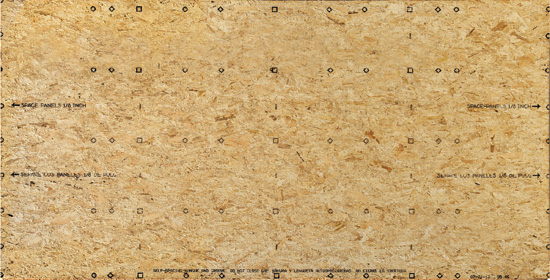Subfloor as a Hidden Asset
Over Joists, Trusses, and Dimensional Lumber
Regardless of the finish floor, glue as well as deformed shank nails or screws should be used for fastening to ensure greater floor performance. Gluing helps eliminate nail-popping and floor squeaks. Manufacturers generally recommend adhesives that conform to industry standard APA AFG-01 or ASTM D 3498, while high-performance panel manufacturers also recommend that the adhesive be solvent or polyurethane based. Using a construction adhesive on floor joists as well as at tongue and groove joints will help increase the stiffness of a floor system.
Before each panel is placed, a line of adhesive should be applied to the top of the joist. Check the panel manufacturer's instructions to ensure compatibility of the adhesive with the subfloor, but note that polyurethane or solvent-based adhesives often form stronger bonds with some types of panels. To prevent skinning of the adhesive prior to attachment of the panel, only enough adhesive should be spread for one or two panels. A 1/4-inch to a 3/8-inch bead of adhesive should be applied to all joist surfaces. For wide surfaces, use a double bead or a serpentine pattern. A double bead is required for the end of the joints as well, and a bead of glue is recommended to run through the groove of the panel to provide a more monolithic structure.
Screws or deformed shank nails will draw the floor and joist together. Naturally, all mechanical fasteners need to engage the underlying framing, an obvious recommendation that in practice does not always occur. If the installer is using a nail gun, he may not realize if the nail hit the joist squarely. Appearances can be deceiving, and installers say that even though subfloors look to be properly nailed down, they may not be. Many times rows of nails can be seen as much as 1/4 inch off the joist. Subfloor products with a fastening guide can help minimize these problems. Some manufacturers provide guides that show the exact location of the joists or trusses below, with directions in both English and Spanish.

Pre-printed fastening guides help ensure faster and more accurate installations.
Photo courtesy of Huber Engineered Woods © 2014
Mechanical fasteners should penetrate framing members at least 1 inch. Apply fasteners 3/8 inches from panel edges. Space fasteners 6 inches o.c. on supported edges (4-foot ends) and 12 inches o.c. at intermediate support locations. Ensure that all corners are securely fastened. Note: 1-1/8-inch panels spaced 48 inches o.c. should be fastened 6 inches o.c. at intermediate support locations.

Fasteners missing joists create squeaky floors and expensive callbacks. A fastening guide helps installers.
Photo courtesy of Huber Engineered Woods © 2014









